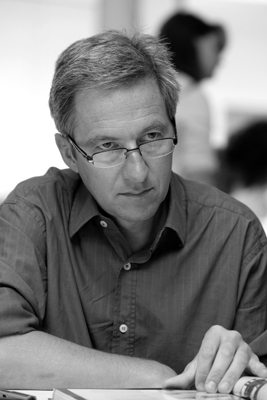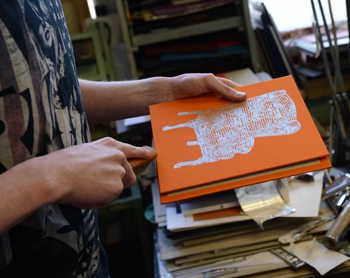There are a few print companies out there who become the default “name” used as the example when discussing a specific print product, and Artisan Books is one of them. After a brief exchange with Francis Atterbury, I understand why. Who wouldn’t default to the man who states, “there will always be a market for quality” – practically brings tears to my print and quality loving eyes!
Check out this short and sweet video and then please read the interview below. More to come on Artisan, I promise!
 DC: Who is Francis Atterbury, and what does he do?
DC: Who is Francis Atterbury, and what does he do?
FA: I was born in 1960 into a family printing business. I grew up at a time of incredible change in the industry and saw first hand the transition from 15th century technology to 21st century. Our family firm pioneered the development of computers in printing. In the early 60s our family firm installed the first multi-colour offset litho press in Europe, developed scanning with John Crossfield and typeset the first book using computer in 1965. All this whilst keeping a craft letterpress tradition alive. I spent time with mathematicians who designed the computer systems and the craftsmen and artists who used both them and the older technology. Of the two, I can assure you that the mathematicians were the bigger drinkers!
I stayed in the industry and spent some time with the Stinehours in Vermont, dish-developing 300# tritones from the camera, worked at Salto in Belgium creating 600¢ facsimile art. I set up and ran a business combining letterpress for type with offset litho for images, running three Monotype casters and two supercasters as well as two and four colour Heidelberg presses. I found and ran a Monophoto 400-8 experimenting with new films placed into the Monophoto matrix case.
Finally, I found and enjoyed developing the quality colour and reproduction capabilities of the HP Indigo presses culminating in our making the first and biggest book made on the 10000 and shown at DRUPA with the launch of the press (the books is 1.2m wide when opened).
My role now is to work out how to make things. I devise the colour separation curves for our books, I decide what papers to use and who to ask to bind.
I work with artists and work out how best to reproduce their work and how to make it.
It’s all about experience and imagination. But mainly imagination…
DC: How did Artisan Books come about?
FA: My wife made a little book of some pictures following my father’s death using an ‘on-line’ photo book company. The book’ that came back was so appalling in terms of quality of materials and binding that I knew my father would haunt me though eternity if I didn’t make him something better.
I decided to distil everything that I knew was important in a book and create a set of production templates that would mean every book we made was as good as it can be whilst being as inexpensive as we could make it. Standardise where it didn’t affect quality or individuality.
DC: Did entering the bookmaking arena require a large investment? What equipment are you using to print and bind?
FA: Although we have chosen not to own the manufacturing equipment, it has taken a substantial investment in terms of time and also in prototyping and finally advance purchase of materials.
We experimented with three alternative digital printing formats testing each against our own standards of reproduction. We were looking for the range of colour gamut available, saturation and ability of the press to handle small, discreet retouches within specific areas of shadow or highlight. In addition, we needed a very predictable press that would continue to deliver the same high quality result each day. The offset digital 7000 & 10000 presses from HP Indigo were the only machines capable of delivering against all our criteria.
The same testing processes were repeated with paper. We needed a paper that could make the most of the colour we had at our disposal and could repeat this every time. In addition, we needed a paper with archival properties as ‘Permanence’ is a key attribute of Artisan Books and the paper had to be printable of offset litho presses as well as offset digital since our longer runs may necessitate different printing processes. Only Mohawk Superfine Eggshell met our criteria for paper.
Finally the binding. We were determined to make the very finest books and for this we needed to test section size, paper weight and cloths. Not all cloths accept foils equally, some will mottle or refuse the metal foil. We needed to find a cloth that felt luxurious but foiled easily. Our bindery made dummies in all the sizes and many of the extents which we used to test and also to establish data for spine widths.
All in all, about 12 months work and £72,000 investment.
DC: Is there a market for custom short run books, who are you promoting your services to, and how?
FA: There will always be a market for quality. I believe that books are becoming less about making money as a book per se and more about being part of a wider communication process. If you are making something, or saying something and that something is important to you then you want the message to get across. However, the market for your message may be small but valuable. You need a book.
DC: What is one bookmaking secret you can share that will save future bookmakers some time and head scratching?
FA: Paper grain direction MUST run parallel to the spine.
DC: If you had to pick and defend one, and in this scenario you do… is printing a craft or a commodity?
FA: At Artisan Books, it’s a craft. If it were a commodity, we wouldn’t need to spend time listening to our clients.
#############
Check out this series of posts and videos about custom bookmaking from our friends at Artisan: Bookmaking Part Two / Part Three / Part Four – and connect with them on Twitter @ArtisanBook and Facebook!
Read more about how HP is Powering Up Publishing!











